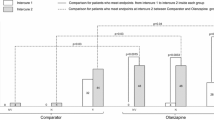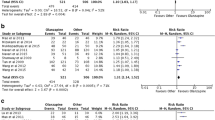Abstract
Purpose
The role of olanzapine added to a dopamine antagonist and benzodiazepine for the treatment of refractory chemotherapy-induced nausea and vomiting (CINV) is incompletely characterized in all levels of chemotherapy emetogenicity. This retrospective study evaluated the efficacy of the addition of olanzapine in adults experiencing refractory CINV stratified by chemotherapy emetogenicity.
Methods
Thirty-three adults who experienced CINV refractory to guideline-recommended prophylaxis and breakthrough antiemetics (dopamine antagonists and benzodiazepines) and received at least one dose of olanzapine 5–10 mg per os were evaluated. Failure was defined as >5 emesis events in 24 h or more than 10 cumulative doses of rescue antiemetics following first olanzapine dose per treatment cycle. Post hoc analyses investigated variables impacting olanzapine efficacy.
Results
The addition of olanzapine demonstrated an overall success rate of 70 %. This success rate did not differ between chemotherapy regimens of high versus low-to-moderate emetogenicity (p = 0.79), prophylaxis with serotonin antagonist plus corticosteroid and aprepitant versus serotonin antagonist alone (p = 0.77), or age over 50 versus ≤50 years (p > 0.99). A trend toward greater benefit was seen in women (p = 0.08).
Conclusions
The addition of olanzapine to a dopamine antagonist and benzodiazepine demonstrated high efficacy rates for refractory CINV irrespective of chemotherapy emetogenicity. The high success rates among all groups suggests that incomplete resolution of CINV with prophylactic serotonin antagonists and breakthrough dopamine antagonists plus benzodiazepine may benefit from the addition of olanzapine regardless of gender, degree of chemotherapy emetogenicity, number of prophylactic antiemetics, or age. The trend toward greater control of emesis in women merits further investigation.
Similar content being viewed by others
References
Albibi R, McCallum RW (1983) Metoclopramide: pharmacology and clinical application. Ann Intern Med 98:86–95
Allison DB, Casey DE (2001) Antipsychotic-induced weight gain: a review of the literature. J Clin Psychiatry 62:22–31
Bateman DN (1983) Clinical pharmacokinetics of metoclopramide. Clin Pharmacokinet 8:523–529
Bymaster FP, Calligaro DO, Falcone JF, Marsh RD, Moore NA, Tye NC, Seeman P, Wong DT (1996) Radioreceptor binding profile of the atypical antipsychotic olanzapine. Neuropsychopharmacology 14:87–96
Bymaster FP, Falcone JF, Bauzon D, Kennedy JS, Schenck K, DeLapp NW, Cohen ML (2001) Potent antagonism of 5-HT(3) and 5-HT(6) receptors by olanzapine. Eur J Pharmacol 430:341–349
De Mulder PH, Seynaeve C, Vermorken JB, van Liessum PA, Mols-Jevdevic S, Allman EL, Beranek P, Verweij J (1990) Ondansetron compared with high-dose metoclopramide in prophylaxis of acute and delayed cisplatin-induced nausea and vomiting. A multicenter, randomized, double-blind, crossover study. Ann Intern Med 113:834–840
Ettinger DA, Barbour S, Berger M, Bierman P, Bradbury B, Ellis G, Kirkegaard S, Kloth D, Kris M, Lim D, Mandrell B, Michaud L, Noonan K, Rugo H, Scullion B, Sorscher S, Stucky-Marshall L, Todaro B, Urba S (2013) Antiemesis (version 1.2013). National Comprehensive Cancer Network, Inc
Fernandez-Ortega P, Caloto MT, Chirveches E, Marquilles R, Francisco JS, Quesada A, Suarez C, Zorrilla I, Gomez J, Zabaleta P, Nocea G, Llombart-Cussac A (2012) Chemotherapy-induced nausea and vomiting in clinical practice: impact on patients’ quality of life. Support Care Cancer 20:3141–3148
Fountaine RJ, Taylor AE, Mancuso JP, Greenway FL, Byerley LO, Smith SR, Most MM, Fryburg DA (2010) Increased food intake and energy expenditure following administration of olanzapine to healthy men. Obesity 18:1646–1651
Herrstedt J, Dombernowsky P (2007) Anti-emetic therapy in cancer chemotherapy: current status. Basic Clin Pharmacol Toxicol 101:143–150
Hesketh PJ (2008) Chemotherapy-induced nausea and vomiting. N Engl J Med 358:2482–2494
Jackson WC, Tavernier L (2003) Olanzapine for intractable nausea in palliative care patients. J Palliat Med 6:251–255
Kaneishi K, Kawabata M, Morita T (2012) Olanzapine for the relief of nausea in patients with advanced cancer and incomplete bowel obstruction. J Pain Symptom Manag 44:604–607
Kast RE, Foley KF (2007) Cancer chemotherapy and cachexia: mirtazapine and olanzapine are 5-HT3 antagonists with good antinausea effects. Eur J Cancer Care 16:351–354
Kris MG, Gralla RJ, Clark RA, Tyson LB, Fiore JJ, Kelsen DP, Groshen S (1985) Consecutive dose-finding trials adding lorazepam to the combination of metoclopramide plus dexamethasone: improved subjective effectiveness over the combination of diphenhydramine plus metoclopramide plus dexamethasone. Cancer Treat Rep 69:1257–1262
Marty M, Pouillart P, Scholl S, Droz JP, Azab M, Brion N, Pujade-Lauraine E, Paule B, Paes D, Bons J (1990) Comparison of the 5-hydroxytryptamine3 (serotonin) antagonist ondansetron (GR 38032F) with high-dose metoclopramide in the control of cisplatin-induced emesis. N Engl J Med 322:816–821
Navari RM, Einhorn LH, Passik SD, Loehrer PJ Sr, Johnson C, Mayer ML, McClean J, Vinson J, Pletcher W (2005) A phase II trial of olanzapine for the prevention of chemotherapy-induced nausea and vomiting: a Hoosier Oncology Group study. Support Care Cancer 13:529–534
Navari RM, Einhorn LH, Loehrer PJ Sr, Passik SD, Vinson J, McClean J, Chowhan N, Hanna NH, Johnson CS (2007) A phase II trial of olanzapine, dexamethasone, and palonosetron for the prevention of chemotherapy-induced nausea and vomiting: a Hoosier oncology group study. Support Care Cancer 15:1285–1291
Navari RM, Gray SE, Kerr AC (2011) Olanzapine versus aprepitant for the prevention of chemotherapy-induced nausea and vomiting: a randomized phase III trial. J Support Oncol 9:188–195
Navari RM, Nagy CK, Gray SE (2013) The use of olanzapine versus metoclopramide for the treatment of breakthrough chemotherapy-induced nausea and vomiting in patients receiving highly emetogenic chemotherapy. Support Care Cancer 21:1655–1663
Passik SD, Lundberg J, Kirsh KL, Theobald D, Donaghy K, Holtsclaw E, Cooper M, Dugan W (2002) A pilot exploration of the antiemetic activity of olanzapine for the relief of nausea in patients with advanced cancer and pain. J Pain Symptom Manag 23:526–532
Passik SD, Kirsh KL, Theobald DE, Dickerson P, Trowbridge R, Gray D, Beaver M, Comparet J, Brown J (2003) A retrospective chart review of the use of olanzapine for the prevention of delayed emesis in cancer patients. J Pain Symptom Manag 25:485–488
Passik SD, Navari RM, Jung SH, Nagy C, Vinson J, Kirsh KL, Loehrer P (2004) A phase I trial of olanzapine (Zyprexa) for the prevention of delayed emesis in cancer patients: a hoosier oncology group study. Cancer Invest 22:383–388
Patterson D, Abell T, Rothstein R, Koch K, Barnett J (1999) A double-blind multicenter comparison of domperidone and metoclopramide in the treatment of diabetic patients with symptoms of gastroparesis. Am J Gastroenterol 94:1230–1234
Pirl WF, Roth AJ (2000) Remission of chemotherapy-induced emesis with concurrent olanzapine treatment: a case report. Psychooncology 9:84–87
Roila F, Boschetti E, Tonato M, Basurto C, Bracarda S, Picciafuoco M, Patoia L, Santi E, Penza O, Ballatori E et al (1991) Predictive factors of delayed emesis in cisplatin-treated patients and antiemetic activity and tolerability of metoclopramide or dexamethasone. A randomized single-blind study. Am J Clin Oncol 14:238–242
Schwartzberg L, Morrow G, Balu S, Craver C, Gayle J, Cox D (2011) Chemotherapy-induced nausea and vomiting and antiemetic prophylaxis with palonosetron versus other 5-HT3 receptor antagonists in patients with cancer treated with low emetogenic chemotherapy in a hospital outpatient setting in the United States. Curr Med Res Opin 27:1613–1622
Shinjo T, Okada M (2006) Olanzapine use in cancer patients for refractory vomiting. Gan To Kagaku Ryoho 33:349–352
Sledge GW Jr, Einhorn L, Nagy C, House K (1992) Phase III double-blind comparison of intravenous ondansetron and metoclopramide as antiemetic therapy for patients receiving multiple-day cisplatin-based chemotherapy. Cancer 70:2524–2528
Srivastava M, Brito-Dellan N, Davis MP, Leach M, Lagman R (2003) Olanzapine as an antiemetic in refractory nausea and vomiting in advanced cancer. J Pain Symptom Manag 25:578–582
Strum SB, McDermed JE, Pileggi J, Riech LP, Whitaker H (1984) Intravenous metoclopramide: prevention of chemotherapy-induced nausea and vomiting. A preliminary evaluation. Cancer 53:1432–1439
Sun CC, Bodurka DC, Weaver CB, Rasu R, Wolf JK, Bevers MW, Smith JA, Wharton JT, Rubenstein EB (2005) Rankings and symptom assessments of side effects from chemotherapy: insights from experienced patients with ovarian cancer. Support Care Cancer 13:219–227
Tan L, Liu J, Liu X, Chen J, Yan Z, Yang H, Zhang D (2009) Clinical research of olanzapine for prevention of chemotherapy-induced nausea and vomiting. J Exp Clin Cancer Res 28:131
Conflict of interest
No sources of funding were used in the preparation of this article. The authors have no real or apparent conflict of interest to declare.
Author information
Authors and Affiliations
Corresponding author
Rights and permissions
About this article
Cite this article
Vig, S., Seibert, L. & Green, M.R. Olanzapine is effective for refractory chemotherapy-induced nausea and vomiting irrespective of chemotherapy emetogenicity. J Cancer Res Clin Oncol 140, 77–82 (2014). https://doi.org/10.1007/s00432-013-1540-z
Received:
Accepted:
Published:
Issue Date:
DOI: https://doi.org/10.1007/s00432-013-1540-z




